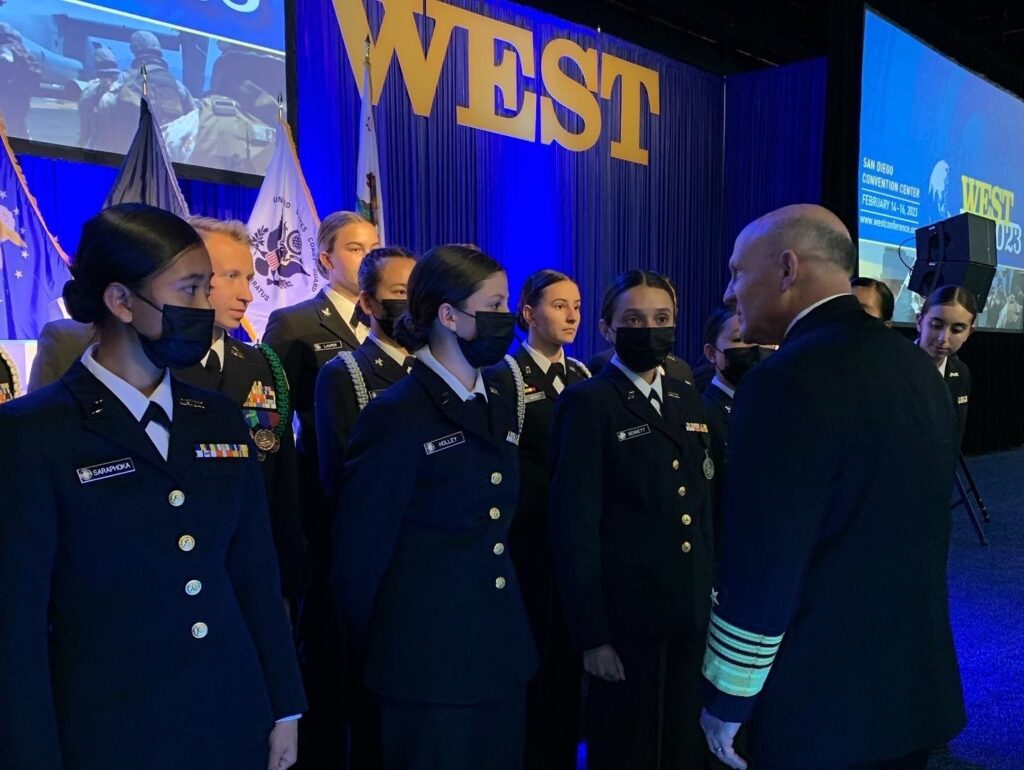
ARLINGTON, Va. — Addressing the topic of future force structure after it submerged again into the depths of analysis, the Navy’s top officer laid out his views for a “bigger, more capable Navy” in the future informed by a series of exercises over the last year, estimating a requirement for a fleet of more than 500 manned and unmanned ships, including 12 aircraft carriers.
“We’re going through another force-structure assessment right now, based on the hard work we’ve done over the last five or years in really thinking about how we would fight differently in terms of in a distributed fashion, across a wide, vast ocean like the Pacific, in terms of integrating all domains simultaneously,” said Adm. Michael Gilday, speaking Feb. 18 at the West 2022 Symposium sponsored in San Diego by the U.S. Naval Institute and the Armed Forces Communications and Electronics Association.
“In thinking about what the future fleet looks like, we spent time taking a look at a couple of different force structures assessments in 2019 and 2020,” the CNO said. “The one that I base my best advice on is the one that we finished up in 2020 that we did along with the Marine Corps, but it was actually led by OSD [Office of the Secretary of Defense]. I found that to be an important stakeholder in that process because this wasn’t just Marine Corps-speak or Navy speak or Department of the Navy-speak, but it was more broadly supported by OSD.
“Based on that [and] large-scale exercises like we did last summer — leveraging live virtual construct [LVC]— based on the integrated battle problem we just did over in 5th Fleet with some 100 unmanned platforms over the past few weeks, I’ve concluded, constant with the analysis, we need a naval force of over 500 ships,” he said.
Gilday said his view on carrier aviation “remains unchanged. I think we need 12 carriers.”
The CNO also said “we need a strong amphibious force to include probably nine big-deck amphibs and another 19-20 [medium amphibious warfare ships] to support them [and] perhaps 30 or more smaller amphibious ships to leverage maritime littoral regiments — and the punch that they’re going to provide in places close inside the fight — to 60 destroyers and probably 50 frigates; 70 attack submarines; a dozen ballistic-missile submarines; to about 100 support ships. And probably, looking to the future, 150 unmanned [vessels].
“We’re doing a lot of work inside the FYDP [future years defense plan] now. I think it speaks out to the vulnerabilities that we hear called out by the Joint Staff and the chairman in his risk assessment,” Gilday said. “So, in the long term, I’m sighted on a bigger, more capable Navy. We’re working our way through that with respect to budgets but certainly not taking our eye off the ball with respect to requirements. We do think differently because the future is now in terms of bringing more capability out of the force that we have.”
- BlueHalo to Test C-UAS System on Marine Corps JLTV - April 29, 2024
- USS George Washington Deploys to U.S. Southern Command, Eventually Headed to Japan - April 26, 2024
- SECNAV Advocates Increased Legal Immigration to Increase Shipbuilder Workforce - April 23, 2024



